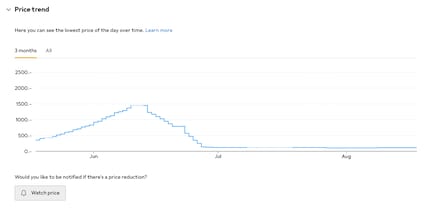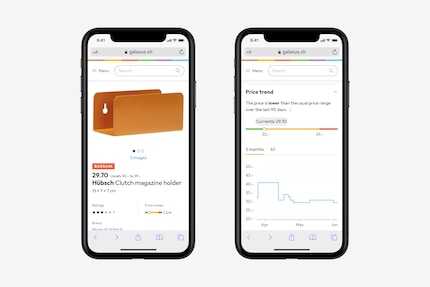
Behind the scenes

Why does a product on Galaxus or Digitec cost more today than it did yesterday? Well, you’re not being tricked – in fact, there’s a system behind it that makes fair prices possible. The prices aren’t changing on a whim, they’re following clear rules.
When you look at a product on Galaxus or Digitec, you often see a different price than the day before. Some are annoyed, others are happy about the unexpected bargain. For Michael Stähelin, Product Owner for Dynamic Pricing, this is part of everyday life: «Price stability is a myth in online retail,» he says. «The market is constantly changing – and we change with it.»
A quick online search is all it takes to find the cheapest provider. «Compared to brick-and-mortar retail, there’s much greater price transparency in online retail,» Michael sums up. To ensure that Digitec and Galaxus offer competitive prices, a self-developed price algorithm adjusts them up to five times a day.
Our prices are the same for everyone at all times – whether they’re in Zurich, Engadine or Geneva. It doesn’t matter which device you use to browse our shops or how often someone has already looked at the product. No personalised pricing, no tricks. «Dynamic pricing like this has a bad image and has its origins in the airline industry – passengers often pay completely different prices for the same flight,» says Michael.

In 2021, Galaxus began displaying how the prices of products develop over time. What’s intended to help our customers make a purchase decision can sometimes cause a stir. The algorithm’s supposed to prevent a price curve like the one seen for the water cooler from Corsair. «In this case, our system was geared towards the prices of the competition – and the two systems battled with each other, causing a spike», says Michael.
The price adjustment algorithm is based on a specially developed system that draws on external and internal data.
Despite how much we love data, at Galaxus and Digitec, human oversight is still key. With millions of price changes per day, errors are inevitable. That’s why a team of five developers led by Michael has set up alarms. If, for example, thousands of prices change significantly at the same time, the sirens go off. The team then immediately checks what’s going on.
Our system is designed to react to market changes – not overreact. Nevertheless, Michael and his team are repeatedly confronted with criticism: «You’ve increased the prices because «Kassensturz» gave the product a good rating!» Or: «You’re playing with unrealistically high prices!» Michael can understand the scepticism. «On a technical level, our system mainly reacts to the offerings in the market – but we also know that prices are loaded with emotions», he says. «When an item is suddenly 30 per cent more expensive, it seems unfair – even when there’s an explanation.» For example: in March 2025 the Swiss consumer magazine «Kassensturz» tested epilators. Demand skyrocketed, and shortly afterwards, we and several of our suppliers were sold out at short notice. The system then switched its focus to a more expensive marketplace merchant that chooses the prices for itself. The result? Wildly fluctuating prices within a few hours. It’s clear to Michael: «Price fairness doesn’t end with the algorithms. We have to remain transparent – and maintain our stance even when the market goes crazy in the short term.»
Despite all the technological sophistication, our primary goal remains the same: a pricing strategy that benefits both us and our customers. Fair, transparent and comprehensible – even if the market’s constantly changing.
Over 99 per cent of all prices (excluding our marketplace) on the two platforms Digitec and Galaxus are set automatically and therefore often several times a day. The exceptions are special offers. Our employees continue to set these prices. Despite all the automation, we don’t want to relinquish control: «It’s important to us that we can always explain why a price is the way it is,» says Michael. «And that we can intervene at any time if something gets out of hand.»
Further measures to increase transparency are planned for the future. One approach was recently developed by a team at the Digitec and Galaxus Hackfest. The idea was to have a traffic light which shows whether a price is particularly high or low. In this way, Galaxus is able to offer customers a further decision-making aid.

«Online retail without dynamic prices is unthinkable today,» summarises Michael. «But with the right balance of automation and human control, we’re creating a system that benefits both us as a company and our customers.»
*What do you think of dynamic pricing? And would you like us to be even more transparent about when a product is particularly good value for money?
As a Multimedia Producer, preparing multimedia content and knowing about cutting-edge technology is my business. My main focus at digitec is producing videos. I can’t wait to try out new products such as cameras, drones or smartphones as soon as they’re launched. This is where being at the source comes in rather handy. When I’m not working, I’m probably skiing, biking or hiking – the mountains are my place to be.
News about features in our shop, information from marketing and logistics, and much more.
Show all